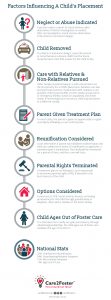Process for Getting Children Back After Removal by Sc Dss
As someone who was placed in foster care (as a child) and also worked placing children in foster care (as a case worker in my young adult life), I know firsthand it is a hard experience for everyone involved. It is traumatic for the child and the family, and I do not want to downplay that. When I entered foster care at 12 years old, my father has just passed away the summer before, my mother was in jail for credit card fraud, and I was living with my 18-year-old sister who had just had a baby and was supporting us on a waitress' pay. I felt scared, angry, and alone; to this day it was the most traumatic experience I have ever had. But it can also be a very hard experience for the case manager.

When I worked for SC DSS, I was a Child Protective Services (CPS) Investigator. Whenever someone made a report about a child being abused or neglected, my job was to investigate. Sometimes it resulted in me having to place a child in foster care and facilitate this process. Unlike the popular myth that DSS likes to come in and "take kids", SC DSS case managers do not have the power to make that decision. If I felt a child was in imminent danger and I could not find a family member or family friend suitable to care for the child with whom the parents or guardians agreed the child could be placed, I had two options:
- To request a law enforcement officer to Emergency Protective Service (EPS) the child, as law enforcement does have the authority to remove a child.
- To request an Ex-Parte Order from a judge.
One or two of those things must take place to move a child. Once a child is placed in foster care, the case manager is charged with making all possible attempts to find someone suitable to care for the child. An older sibling, grandparent, aunt or uncle, family friend… anybody. In my experience, it is far less traumatic to place a child with someone they know than to be placed with someone they do not.

Within 72 hours of a child being placed in foster care, the law states a Probable Cause Court Hearing must be held. At this hearing, the judge does not want to hear every detail of the case, they simply want to know if DSS had adequate reason to request an Ex-Parte Order or for law enforcement to EPS a child. The parent or guardian of the child is present at this hearing and may present why their child should not have been taken from them. The judge will either uphold the decision of DSS for removal or order the child to be returned home. The judge will also appoint a Guardian Ad Litem (a court-appointed volunteer who speaks to the best interest of the child at court hearings).
In our US government, we have a checks and balance system of the judicial branch, the executive branch, and the legislative branch to keep one branch from overpowering the others. Foster care functions similarly– the Guardian Ad Litem is a third party for the child in court. DSS is focused on safe reunification, while the parents or guardians present their views, and the Guardian Ad Litem speaks to the best interest of the child.
30 days after a child has been placed in foster care, a Merits Hearing is held. At this hearing, DSS represents their case, the Guardian Ad Litem presents their findings, and the parents or guardians present their views. At a merits hearing the judge wants to know what attempts have been made to place the child with family or friends of family members. Also at this hearing, DSS will present what is called a treatment plan. A treatment plan outlines what the parents must do in order for the child to return home and a time frame for doing so.
The Treatment Plan has been an issue for DSS for some years, as it only lists expectations for parents (such as receiving therapy, attending parenting classes, obtaining safe housing, etc.). Some argue it does not help parents develop behavior changes that will prevent them from having DSS open another case in the future. The judge will either accept or reject the treatment plan that DSS has outlined at the merits hearing. Afterwards, the parents or guardians must adhere to the court ordered treatment plan. Once this is complete, the investigator case manager is no longer involved in the case. A foster care case manager takes over the case and will coordinate visits with the child and family, work with the parents on the treatment plan, and work with the Guardian Ad Litem on what is needed.

For foster parents: What is most helpful is honest relaying of relevant information you receive from and about the child in your care. As the foster parent, you are the primary caregiver and spend more time with the child than anyone else. If the child shares they miss older siblings or an uncle or someone who is not blood related but close to their family, let the case worker know. Parents are not always forthcoming with possible relatives, but the child might be. This information could allow a child to be placed with a relative or alternative caregiver. For me personally, my paternal uncle was never contacted about taking care of me while I was in foster care. My mother never told anyone about him, and I was never asked. Years later after I left foster care I reconnected with my uncle and I asked him if he knew what happened to me or why he didn't try to contact me all those years; he told me no one from DSS ever contacted him, my mother was in jail, and he didn't know anyone else on my maternal side of the family. While I love my life now, who knows that traumas I could have avoided if I had grown up in his home with my cousins.
As someone who has been both the child entering foster care and the case manager, the foster parents are very important to helping the child adjust to their new home while also being the primary resource for them as they are away from their family, however long that is. If there are two things I would like you to take away from this it is:
One, Thank you for all the sacrifice, love, and support you are offering the child entering your home. Secondly, please know that your voice IS vital throughout the process, both for the child and for the case manager.
Daniel
Daniel was in the foster care system in South Carolina from ages 11 to 19 years old, where he lived in nine foster homes and two group homes. After aging out of foster care, Daniel received his bachelors and masters degrees and now works at a nearby university. Prior to this, Daniel worked for social services helping children in foster care. Daniel is now passionate about sharing his experiences with others, to inspire more families to foster children. Follow his posts to learn what it is like being a child in foster care!
Process for Getting Children Back After Removal by Sc Dss
Source: https://fgi4kids.org/heavy-loads-a-dss-case-managers-perspective/